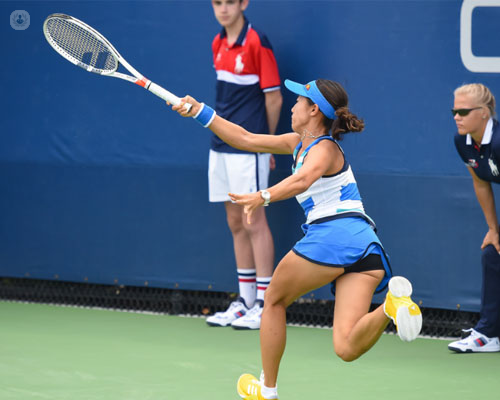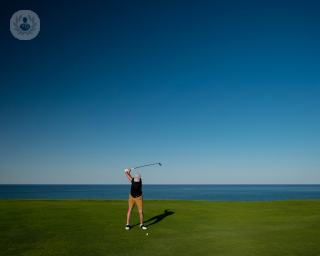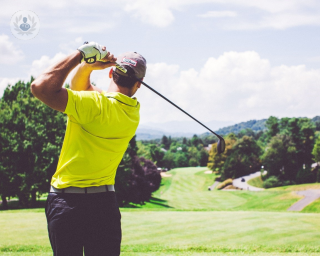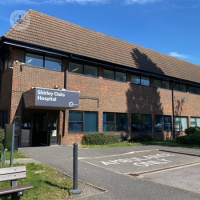Epicondylitis (tennis elbow)
Mr Christopher James - Orthopaedic surgery
Created on: 11-13-2012
Updated on: 10-06-2023
Edited by: Carlota Pano
What is lateral epicondylitis?
Lateral epicondylitis, also known as tennis elbow, is an injury that causes pain on the outside of the elbow. It is due to repeated wrist extension and forearm supination movements. Repeated use of these muscles causes microinjuries to the tendon. If this persists over time, irritation and pain develops on the outside of the elbow.
Although commonly known as tennis elbow, this condition is suffered not only by tennis players but also by anyone who performs work that involves repetitive stretching and flexing movements of the forearm and wrist. Some examples include professional painters, mechanics, labourers, or those who work long hours in front of a computer using a mouse.

Prognosis of the disease
Lateral epicondylitis is not a very serious injury, though it can significantly affect your life. Most people improve with non-surgical treatments and the condition can even be cured. Symptoms often persist for several months before the condition is completely cured.
Symptoms of lateral epicondylitis
Lateral epicondylitis is characterised by the following symptoms:
- Pain and movement difficulties when extending the wrist
- Pain on the outside of the elbow
- Pain with some basic movements, like lifting a cup of coffee
This pain does not go away with rest or by applying local cold or taking anti-inflammatories.
Medical tests for lateral epicondylitis
Every trauma specialist should perform a thorough evaluation in order to diagnose lateral epicondylitis. Among other procedures, this will include:
- A visual exam to check the appearance of the skin, possible swelling of the area, and to make sure the joint is aligned properly
- Using the hands to feel the area and evaluate pain
- A "chair test", which entails lifting a chair with the palm of the hand facing downwards and the elbow in extension. Pain usually prevents this action from being performed
- Pain assessment by extending the fingers and wrist against resistance, and extending the middle finger against resistance with the elbow extended
- Other assessments of pain and mobility such as the Mill’s manoeuvre
Can it be prevented?
Lateral epicondylitis can only be prevented with careful “postural hygiene”. Proper movements during sport and work will ensure that the tendons are not subjected to excessive stress. Resting your elbow well after a busy session can also help prevent epicondylitis. Stretching and preventive massages, as well as elbow pads, are helpful.
Treatment for lateral epicondylitis
Treatment for an injury of this nature should be gradual and depend on the severity of the injury.
Initial recommendations include:
- Nonsteroidal anti-inflammatory drugs, oral or topical.
- Resting the elbow, reducing activities that cause pain, and reducing the duration and intensity of exercise.
- Physiotherapy and application of local heat, massages, shock waves, ultrasound, as well as exercises and techniques.
If these measures are not effective, the following will be recommended:
- Local corticosteroid infiltrations or injections (with or without anaesthetic). These can improve pain for a period of time and stimulate healing when injected near the affected area. In some cases, three infiltrations are performed at 1/2-week intervals. However, infiltrations are usually limited to three, as there is a slight risk of rupture of the tendon and tendon insertion. At present, platelet-rich plasma infiltrations are also used.
- Limiting movements or activities that cause epicondylitis. In this respect, a study of your workplace should be carried out, which will be key to a successful cure. You should also reduce the practice or play intensity of racquet sports.
If the above treatments also prove ineffective and you still suffer from the symptoms and pain of epicondylitis, surgery will be the next option. Surgery can be performed with an open incision, or using arthroscopy. Arthroscopy is currently the most commonly-used technique as it gives access to the lesion with a miniature camera, through two or three small incisions. This technique is minimally-invasive, so recovery is faster and less painful.
Which specialist treats it?
Epicondylitis is treated by a trauma specialist, who usually has specific training in the treatment of elbow pathologies.
Other professionals may be involved during recovery from an epicondylitis injury, such as physiotherapists, who will provide practical exercises to restore movement, and orthopaedic surgeons, to repair the tendons in the elbow when other treatment approaches have failed.
















